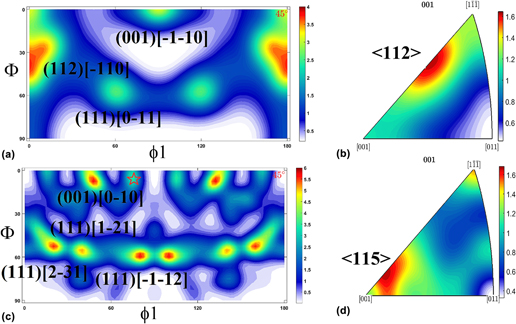Article contents
In situ neutron diffraction study on tensile deformation behavior of carbon-strengthened CoCrFeMnNi high-entropy alloys at room and elevated temperatures
Published online by Cambridge University Press: 22 June 2018
Abstract

Carbon is doped into a CoCrFeMnNi high-entropy alloy as an interstitial atom, improving the single phase solid solution alloy with a good combination of strength and ductility at room temperature by introducing deformation twins. In situ neutron diffraction (ND) is applied to investigate the carbon-doped CoCrFeMnNi deformation mechanism and micromechanical behaviors during uniaxial tension at room and elevated temperatures. With in situ results accompanied with the microstructure and texture measurement, it is found that the plastic deformation is dominated by dislocation slip at an early stage at both temperatures. However, at high strain level, deformation is mediated simultaneously by deformation twins and microbands at room temperature, while it is governed solely by microbands at elevated temperature of 573 K. The evolution of lattice strain, peak intensity, and peak width from in situ ND elucidates the micromechanical behaviors regarding the role of slips and twins. The texture represented by orientation distribution function indicates that the initial specimen possesses a relatively strong {112}〈110〉 texture component, and the room-temperature tension deformed texture comprises of slip-induced fiber texture and twinning-induced {115}〈552〉 texture component.
- Type
- Article
- Information
- Journal of Materials Research , Volume 33 , Issue 19: Focus Issue: Fundamental Understanding and Applications of High-Entropy Alloys , 14 October 2018 , pp. 3192 - 3203
- Copyright
- Copyright © Materials Research Society 2018
Footnotes
This manuscript has been authored by UT-Battelle, LLC under Contract No. DE-AC05-00OR22725 with the U.S. Department of Energy. The United States Government retains and the publisher, by accepting the article for publication, acknowledges that the United States Government retains a nonexclusive, paid-up, irrevocable, worldwide license to publish or reproduce the published form of this manuscript, or allow others to do so, for United States Government purposes. The Department of Energy will provide public access to these results of federally sponsored research in accordance with the DOE Public Access Plan (http://energy.gov/downloads/doe-public-access-plan).
References
REFERENCES
- 7
- Cited by


